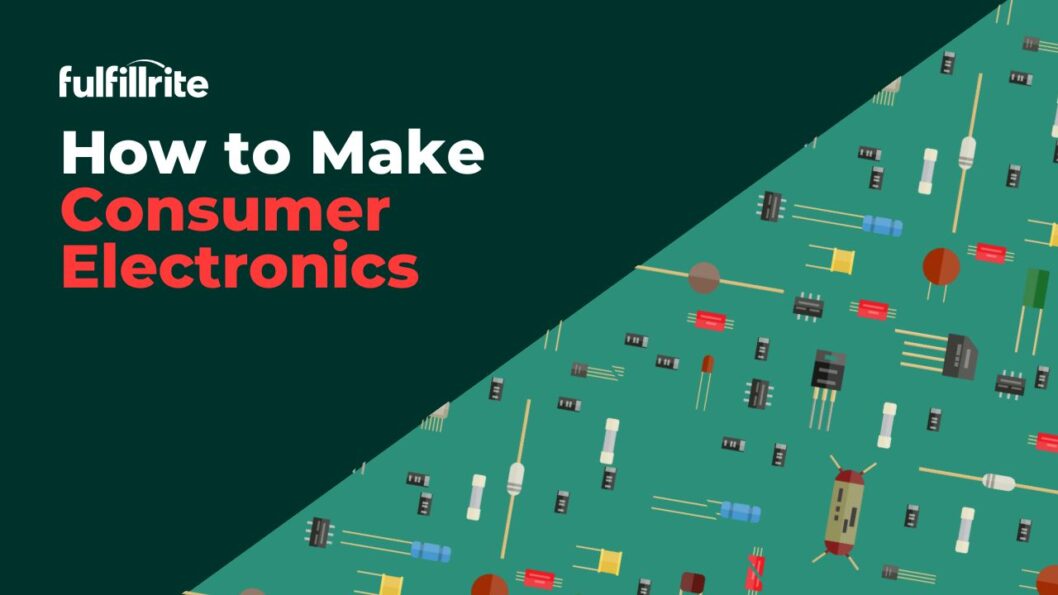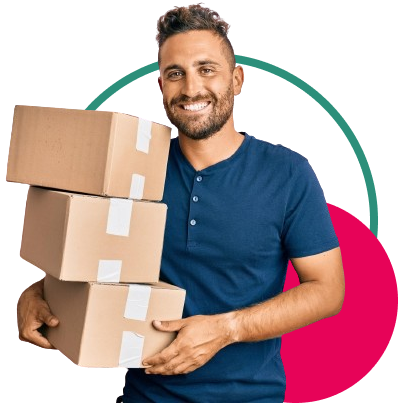Building a consumer electronics product is a long, complicated process. Even when everything goes right, it’s still hard.
Design takes time. Manufacturing has lead times. Certification takes its sweet time. And testing, always necessary, reveals problems you didn’t even know to look for.
And all the while, the clock is ticking—especially if you’ve promised backers or customers a launch window.
This guide is here to help. It’s not exhaustive, but it’ll give you a big-picture view of what it takes to go from idea to delivery.
And while we want you to know that Fulfillrite is an order fulfillment center for consumer electronics, this isn’t a sales pitch. It’s the advice we wish more early-stage founders had when they started.
With that said, let’s talk about how to get consumer electronics made.
Step 1: Define the Product
Don’t skip this step. That seems obvious, but you’d be surprised how many people do. They start building before they really know what they’re making.
You need a clear answer to this question: What problem are you solving?
Not “what’s a cool feature” or “what would be fun to build.”
You need a real, specific, annoying problem that a specific kind of person has. The more focused your answer, the better the rest of this process will go.
Once you’ve got that, ask: who’s the target user? What matters most to them? What’s non-negotiable functionality, and what’s just nice to have?
And finally, think about how your product ought to look and feel. Industrial design and user experience matter in electronics.
People judge these things fast. Does it feel sturdy? Intuitive? Does it look like something that belongs in their home or bag?
Start simple. Get to something testable quickly. Your v1 is not your forever product. It’s your entry point.
Step 2: Build the Bill of Materials (BOM)
Once you know what you’re building, you need to know what goes into it. That’s your bill of materials (BOM).
A BOM is a detailed list of every single component in your product. Not just the circuit board and battery, but also the screws, buttons, wires, casing, foam padding. Truly everything.
Why does this matter? Because your BOM determines a lot:
- Your cost to produce
- Who you can work with for sourcing
- How complex your supply chain will be
- What kind of packaging and shipping constraints you’ll face
You may find yourself going back and forth between defining the product, building the BOM, and prototyping in a loop. That’s OK and is, in fact, very normal.
With BOM building, in particular, though, you’ll want to pay attention to where SKU complexity sneaks in. Let’s say you offer your product in three colors and two regional plug types. That’s already six SKUs. Add firmware variants? You’re pushing into double digits fast.
Sometimes that’s necessary. But if you’re still pre-launch, simplify. It keeps your BOM under control.
Fulfillrite, as with many order fulfillment centers, can handle complex kits. It’s a routine service and common. But even with the best fulfillment center, you should know that simpler kits mean fewer things can go wrong in the shipping stage. Keep it lean at first. You can always expand later.
Step 3: Source & Prototype
You’ve got your design. You’ve got your BOM. Now it’s time to start building.
This usually starts with a design engineer or a product development firm—someone who can turn your idea into something manufacturable. They’ll often help you build early prototypes, do printed circuit board (PCB) layout, and get the basic enclosures together.
You don’t have to go big here. 3D printing and small-batch PCB shops make early-stage iteration a lot cheaper and faster than it used to be.
That said, start thinking about suppliers now. Will you source components overseas or domestically? Each has tradeoffs:
- Overseas is usually cheaper (even with tariffs), but takes longer and comes with communication risk
- Domestic is faster and easier to manage, but costs more per unit
A note on packaging: plan it now. Not after production. Too many founders push packaging to the end and then scramble when their warehouse calls to say 30% of units arrived crushed.
Many fulfillment centers provide protective packaging options—anti-static bags, custom inserts, crush-proof boxes. And that can certainly make a huge difference. But everything starts with how your product is designed and what’s feasible at scale.
4. Compliance & Certification
Once your prototype is functional, it’s tempting to go full speed ahead to manufacturing. But you ought to pump the brakes before you do that.
You can’t skip the compliance step. If you want to sell legally, and keep your customer support inbox from filling with angry messages, you need certification.
What certifications might you need?
- FCC (USA) – Required for almost any device that emits a radio signal or has wireless components.
- CE (Europe) – A broad mark of conformity with health, safety, and environmental protection standards.
- UL – Primarily a safety certification for electrical components and fire risk.
- RoHS – Restricts hazardous substances (mostly in the EU, but increasingly global).
Even if your device feels “low-tech,” these rules probably apply.
Certification isn’t just a rubber stamp.
It takes time and budget. Some labs move quickly; others don’t. Some countries require testing in-country. Some require registration. And if you make even a minor change to your device—switching to a different battery, changing the PCB layout—you may have to recertify.
Factor this into your timeline. It can take weeks or even months to get the green light to ship internationally.
5. Testing
The sooner you break your product, the better. If you don’t, your customers will.
Do the functional tests.
Make sure your device actually does what you say it does. Try it with edge cases: the wrong charger, low battery, inconsistent Wi-Fi, temperature swings. Make sure firmware behaves as expected. This is also a good time to start version control so you can know which unit has which firmware build.
Do the stress and drop tests.
Does the product survive a fall from waist height? What about in its shipping box? Does it fail silently, or short something? If you don’t test this yourself, your customers will do it for you while looking into a front-facing camera and a ring light.
Build a small test run.
Before you order 10,000 units, make 50 or 100. Ship them to testers. Give them away if you have to. Use this to identify QA issues, gauge user sentiment, and figure out what breaks.
Then fix it.
6. Manufacturing at Scale
You’ve got a working prototype, you’ve run your tests, and you’re certified to sell. Now you need to build hundreds, or thousands, of units. That’s where contract manufacturing comes in.
Choosing a contract manufacturer (CM)
Look for a partner who has built products like yours before. That sounds obvious, but too many startups go with the cheapest quote or the first warm intro. The right CM will understand your product category, speak clearly about timelines and minimum order quantities (MOQs), and flag design-for-manufacturing (DFM) issues early.
Ask about their quality control process. Ask who handles procurement. Ask what happens when a component goes out of stock.
And be prepared to pay for a test run.
Most reputable manufacturers will offer a pilot production run—a small batch of your product made using full-scale processes. This is where you’ll catch the stuff that didn’t show up in prototyping: misaligned screw holes, screen bleed, parts that don’t fit right on the line.
Don’t assume timelines will hold.
A quote might say “4 weeks for production,” but that doesn’t include delays from component shortages, tooling changes, customs holdups, or freight congestion. Build margin into your timeline. Double it if you’re launching near the holidays.
Be specific, not vague.
At scale, imprecision costs real money. If your assembly instructions say “insert the charging cable,” but don’t specify the orientation or exact slot, you might get 5,000 units with upside-down cables and no recourse.
7. Fulfillment & Delivery
Let’s talk about what happens after manufacturing: how your product gets into customers’ hands.
Consumer electronics are tricky to ship. You’ve got a high-value item that needs protective packaging, precise kitting, and accurate tracking. Customers are sensitive to delays. And if something goes wrong, support queues pile up fast.
This is where Fulfillrite fits in.
Launch-day fulfillment
If your launch is tied to a press event, a crowdfunding go-live, or a retail partner push, you don’t have time to “ease in.” You need to ship thousands of orders in one go. This is one of the reasons why we specialize in launch-day fulfillment. Our clients like knowing that their inventory is pre-kitted, labeled, and staged well in advance of the big day.
That momentum you spent six months building? It doesn’t die in the warehouse.
Complex kits
Your product ships with cables, adapters, manuals, and inserts. Maybe multiple SKUs for different regions. Maybe special packaging for influencers. Maybe an extra part for customers in Germany.
We follow detailed instructions, verify each kit, and make sure every box has what it’s supposed to have—no more, no less. You don’t want a 3PL that wings it. You want one that reads the packing SOP and gets it right.
Returns and refurb support
Electronics get returned. Sometimes they’re DOA. Sometimes the buyer just changes their mind. Many 3PLs won’t touch returns—they’ll tell you to deal with it yourself.
We handle it in-house. Units get inspected, re-kitted, and restocked if they pass QA. If they’re broken, we’ll quarantine them. That means fewer write-offs for you and less confusion for your support team.
International shipping
If you need help shipping internationally, you need a 3PL that provides global fulfillment with customs documentation, VAT handling, and Delivered Duties Paid (DDP) options. That means your customer in Sweden gets the product without a surprise tax bill—and you don’t get a one-star review because of shipping confusion.
Real-time inventory
You shouldn’t have to email someone to ask if you’re low on blue USB-C cables. Look for a fulfillment center whose system gives you full dashboard access with real-time inventory levels, order statuses, and tracking info. You need to know what’s in stock, what’s moving, and what needs reordering, down to the unit.
Fulfillment support
Before you start working with any fulfillment center, make sure you can rely on them for support when you need it. This is something we take particularly seriously at Fulfillrite.
That’s why we assign you a dedicated account rep who knows your product. They answer emails fast. They call you back. They fix problems. You don’t end up in some ticket queue waiting three days to find out if someone scanned the wrong SKU.
Final Thoughts
Building a consumer electronics product is not for the faint of heart. You need design, sourcing, engineering, testing, manufacturing, and logistics all working in sync—and at speed.
You will make mistakes. That’s fine. But the fewer you make early, the less painful your launch will be.
The goal of this guide wasn’t to overwhelm you. It was to give you a map, so you can make informed decisions and avoid the obvious landmines.
When you’re ready to ship, Fulfillrite is here. We’ve helped many electronics brands go from “We just got funded” to “We just shipped 10,000 units without a single backorder.” We can do the same for you.

